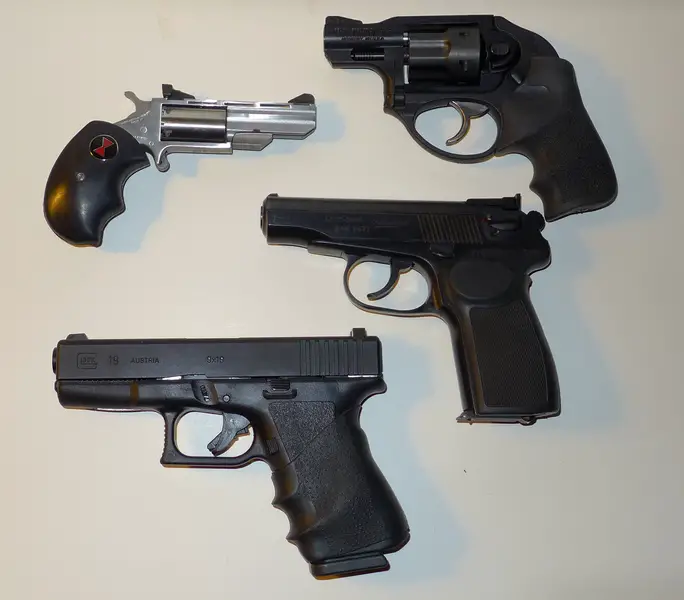


Handguns for Self-Defense, Part Two
Above, a few self-defense options. Clockwise from the upper left, they are the NAA Black Widow .22 WMR, Ruger LCR .22 WMR, Makarov .380, and the Glock 19 9mm. The most effective one for you is the one in your hand that you can use quickly, accurately, comfortably, and intuitively.
Handguns for Self Defense, Part One was necessary to show that handguns are only fifteen to twenty percent lethal, the silly myth of the “one shot stop” is silly and reliance on that could get you killed. While one shot from a .22 rimfire could be lethal, ten shots from a 9mm may not be. As Dr. Martin Fackler, Dr. Di Maio, and the FBI have long shown, it is largely a matter of the luck of the draw.
Handguns wound by crushing tissue, the two most important factors are penetration and permanent cavity. For your self-defense handgun, you really need to be absolutely comfortable with it and need to be able to hit what you are shooting at, if forced to shoot, easily, instinctively, and intuitively. A .22 rimfire that you can hit with is far more valuable to you than a .454 Casull that jumps out of your hand, or a lightweight .44 Remington Magnum that punishes you to the point that you dread practicing with it and as a result, never do.
If concealability is not a factor, as in your home or perhaps your vehicle, large, heavy, smooth, comfortable, and large capacity is the preferred defense arm. An attack isn't a planned event, it may not be one intruder, and while a couple of shots might possibly end an attack, a dozen shots could be inadequate. This is life-support equipment, after all, the lives of your kids, your spouse, and yourself are what is at stake. Unless you can think of some compelling reason not to use a 15 or 17 round 9mm for example, there is no excuse not to. Obviously, your purpose is not to kill, but to end an immediate threat. You need to place as many bullets in the cardiac / pulmonary triangle of your assailants as needed to end the threat.
“It is essential to bear in mind that the single most critical factor remains penetration. While penetration up to 18 inches is preferable, a handgun bullet MUST reliably penetrate 12 inches of soft body tissue at a minimum, regardless of whether it expands or not.” (Handgun Wounding Factors and Effectiveness, FIREARMS TRAINING UNIT FBI ACADEMY QUANTICO, VIRGINIA July 14, 1989). Expansion (actually, deformation) is good as is a large bullet diameter, but never at the expense of penetration. Simplified, a larger diameter bullet or bullet deformed to a larger diameter may destroy a structure that a smaller projectile frontal area might miss entirely. When penetration is inadequate, no structure can be damaged at all beyond the insufficient penetration depth. Naturally, you'll want to get proper training and practice, practice, practice.
As far as a few generalizations: always go with the highest capacity firearm possible. The bad guys do, self-defense is an unexpected event and handguns are not particularly lethal. It is unforeseeable to know how many shots it might take to thwart an attack against assailants, for there are countless variables. The higher capacity firearm is invariably a better choice for self-defense. With no way to know what it might take to save your cookies, you need to have as many ballistic cookies at your disposal as possible.
If a handgun is uncomfortable or painful to shoot for you, you have the wrong gun. If you can't hit what you are shooting at, you have the wrong gun. For concealed carry, if a firearm is bulky or heavy to the point where you don't have it with you, then that is a lousy choice for your application as well. The bigger the hole a handgun makes the better, as long as you have adequate penetration. Guns that make big holes are of little help if their capacity is inadequate or if they are clumsy, cumbersome, or uncomfortable for you to operate.
There
is little question that classic chamberings such as the 9mm, .357, and
.45 ACP offer acceptable penetration. However, if the bulk or recoil makes
those options unsuitable for you, the .380 or even the .22 WMR (both with
premium ammo) offer less penetration than optimal (9 - 10 inches) yet
the handgun in your hand is invariably better than the one locked up somewhere
else and the handgun you find pleasant to operate and easy to hit with
beats the loud noisemaker you have trouble hitting with.
Copyright 2013 by Randy Wakeman. All Rights Reserved.




